» posted on Thursday, August 15th, 2013 by Linda Lou Burton
He Never Set Foot
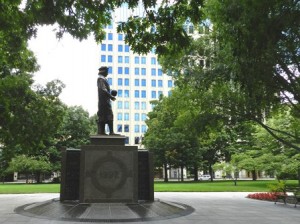 Linda Burton posting from Columbus, Ohio – A statue of Christopher Columbus nestles under the buckeye trees on the southwest corner of the Ohio Statehouse grounds. It isn’t quiet there; the statue faces busy High Street and a main stop for the COTA buses; to his left across State Street the marquee on the Ohio Theater flashes for events; a highrise hotel on the corner welcomes visitors to Columbus. But Chris looks peaceful enough, reflectively studying the globe in his hand. A few blocks away, in Battelle Riverfront Park, the Santa Maria floats gently on the Scioto
Linda Burton posting from Columbus, Ohio – A statue of Christopher Columbus nestles under the buckeye trees on the southwest corner of the Ohio Statehouse grounds. It isn’t quiet there; the statue faces busy High Street and a main stop for the COTA buses; to his left across State Street the marquee on the Ohio Theater flashes for events; a highrise hotel on the corner welcomes visitors to Columbus. But Chris looks peaceful enough, reflectively studying the globe in his hand. A few blocks away, in Battelle Riverfront Park, the Santa Maria floats gently on the Scioto 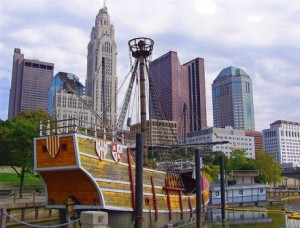 River. It’s a replica of course, open for public tours, and offering educational programs about life, and sailing, in Christopher Columbus times. Chris is a major presence in Columbus, Ohio, even though he never set foot anywhere remotely near. The “explorer’s mystique” surrounds his name; it has been chosen for cities and parks all over the world; his statues are everywhere too. The one on the Ohio Statehouse grounds isn’t a heavy-duty marble; it is crafted of hammered copper plates joined together with rivets and was created in the workshops of W H Mullins Company in Salem, Ohio in
River. It’s a replica of course, open for public tours, and offering educational programs about life, and sailing, in Christopher Columbus times. Chris is a major presence in Columbus, Ohio, even though he never set foot anywhere remotely near. The “explorer’s mystique” surrounds his name; it has been chosen for cities and parks all over the world; his statues are everywhere too. The one on the Ohio Statehouse grounds isn’t a heavy-duty marble; it is crafted of hammered copper plates joined together with rivets and was created in the workshops of W H Mullins Company in Salem, Ohio in 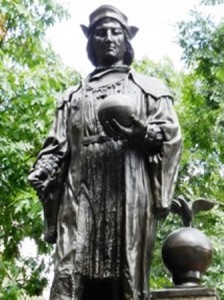 1892, as the 400th anniversary of Columbus’ first voyage approached. Americans looked for ways to recognize what many felt was the beginning of the nation’s history; in Columbus Monsignor Joseph Jessings, founder of Pontifical College Josephenium, commissioned a statue and put it on the grounds of the Seminary. In 1932 the statue was given to the state, and has remained on the Statehouse grounds since. The base was added in 1992, the 500th anniversary of Columbus’ voyage; it was rededicated on Columbus Day; presiding were the Mayors and Governors from Columbus, Ohio and Genoa, Liguria, the Italian city and state thought to be Columbus’ birthplace.
1892, as the 400th anniversary of Columbus’ first voyage approached. Americans looked for ways to recognize what many felt was the beginning of the nation’s history; in Columbus Monsignor Joseph Jessings, founder of Pontifical College Josephenium, commissioned a statue and put it on the grounds of the Seminary. In 1932 the statue was given to the state, and has remained on the Statehouse grounds since. The base was added in 1992, the 500th anniversary of Columbus’ voyage; it was rededicated on Columbus Day; presiding were the Mayors and Governors from Columbus, Ohio and Genoa, Liguria, the Italian city and state thought to be Columbus’ birthplace.
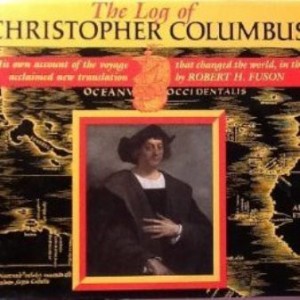 Historians have never agreed on the birthdate, nationality, or physical description of Christopher Columbus, but his voyages are well recorded. He made four in all; the first was in 1492 and that’s when the famous Nina, Pinta, and Santa Maria sailed. He visited the Bahamas, Cuba, and Hispaniola on that journey. On the second voyage in 1493 he returned to the same area with 17 ships; the third voyage, with six ships in 1498, took him further south to the mainland of South America. His fourth voyage began in 1502 with four ships; he was still searching for that elusive “passage to India” and wound up on the coast of Central America, where he was stranded until help arrived in 1504 and he returned to Spain. Though he never set foot on the main part of what became North America; he is often called the European discoverer of America; and certainly, he brought the Americas to Europe’s attention.
Historians have never agreed on the birthdate, nationality, or physical description of Christopher Columbus, but his voyages are well recorded. He made four in all; the first was in 1492 and that’s when the famous Nina, Pinta, and Santa Maria sailed. He visited the Bahamas, Cuba, and Hispaniola on that journey. On the second voyage in 1493 he returned to the same area with 17 ships; the third voyage, with six ships in 1498, took him further south to the mainland of South America. His fourth voyage began in 1502 with four ships; he was still searching for that elusive “passage to India” and wound up on the coast of Central America, where he was stranded until help arrived in 1504 and he returned to Spain. Though he never set foot on the main part of what became North America; he is often called the European discoverer of America; and certainly, he brought the Americas to Europe’s attention.
When the settlement of what is now the United States began, his name was often selected as a poetic representation of America – Columbia, the female personification of Columbus, was first used in place of “America” in 1738. The name for South Carolina’s state capital was chosen as “Columbia” in 1786, beating out the name “Washington;” the “District of Columbia” was created in 1791. And now to the Ohio connection. When Ohio became the 17th state on March 1, 1803, the capital was in Chillicothe; it moved to Zanesville and back to Chillicothe as legislators fought for a more centralized location. Franklinton, Dublin, Worthington, and Delaware were considered; the compromise was to select none of them, but to create an entirely new city.
A site was chosen on the “high banks opposite Franklinton at the forks of the Scioto known as Wolf’s Ridge,” an area that was dense forestland at the time, but offered good transportation via the Scioto and Oletangy rivers. A day of discussion was set aside to select a name for this new city; many were proposed but the argument for “the discoverer of America” won out; Columbus became the new capital city on February 14, 1812. The city was designed from the first as the state’s capital; the town was surveyed, and various city lots were put up for sale. By 1813, a penitentiary was built, and by the following year the first church, school, and newspaper were established. The first statehouse was built in 1814 and the capitol was officially moved. Columbus grew quickly in its first few years, having a population of seven hundred people by 1815. By 1834, the population of Columbus was four thousand people, officially elevating it to “city” status.
 In the following decades Columbus continued to grow both economically and in terms of population; much of the growth was due to its proximity to major transportation routes. Columbus was connected to the Ohio and Erie Canal by way of an eleven-mile feeder canal in September 1831; by 1836, the National Road extended from Cumberland, Maryland, to Columbus, and within the next several years went all the way to Illinois. In the 1840s and 1850s, railroads and telegraph lines connected the capital to other parts of the state as well.
In the following decades Columbus continued to grow both economically and in terms of population; much of the growth was due to its proximity to major transportation routes. Columbus was connected to the Ohio and Erie Canal by way of an eleven-mile feeder canal in September 1831; by 1836, the National Road extended from Cumberland, Maryland, to Columbus, and within the next several years went all the way to Illinois. In the 1840s and 1850s, railroads and telegraph lines connected the capital to other parts of the state as well.
Columbus was a major base for the volunteer Union Army that housed 26,000 troops and held up to 9,000 Confederate prisoners of war at Camp Chase, located at what is now the Hilltop neighborhood of west Columbus. Over 2,000 Confederate soldiers remain buried at the site, making it one of the largest Confederate cemeteries in the North. North of Columbus, along the Delaware Road, the Regular Army established Camp Thomas, where the 18th US Infantry was organized and trained. Industries really began to grow in the years 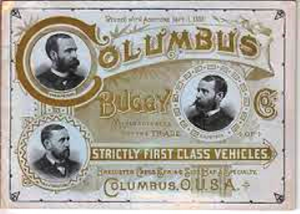 following the Civil War. By the 1880s, there were almost two hundred factories in operation, manufacturing shoes, cigars, farm tools and machinery, furniture, carriages, and brooms; there also were iron manufacturers and foundries, and brewing companies established by German migrants. A major employer was the Columbus Buggy Company; by the late 1800s it was producing one buggy every eight minutes.
following the Civil War. By the 1880s, there were almost two hundred factories in operation, manufacturing shoes, cigars, farm tools and machinery, furniture, carriages, and brooms; there also were iron manufacturers and foundries, and brewing companies established by German migrants. A major employer was the Columbus Buggy Company; by the late 1800s it was producing one buggy every eight minutes.
After the Great Flood of 1913, which left ninety people dead and thousands of West Side residents homeless, the Army Corps of Engineers widened the Scioto River through downtown, constructed new bridges, and built a retaining wall along its banks. A construction boom in the 1920s resulted in a new Civic Center, the Ohio Theatre, the American Insurance Union Citadel, and, to the north, a massive new Ohio Stadium. And in 1932, remember, the statue of Christopher Columbus took up its post on the grounds of the Statehouse, right in the heart of downtown.
The effects of the Great Depression were somewhat less severe in Columbus, due to the city’s diversified economy. World War II brought new jobs to the city, and another population surge; the majority of new arrivals were migrants from depressed rural areas of Appalachia, who would soon account for more than a third of Columbus’ rising population. Interstate highways brought suburban development, and annexation; by the early 1990s, Columbus was  Ohio’s largest city in both land area and in population, and remains so today. Highrise office buildings, cultural institutions, and sweeping condominiums fill the area that once was dense forestland on the “high banks across from Franklinton.” Today’s workforce is occupied in the fields of education, government, insurance, banking, fashion, defense, aviation, food, clothes, logistics, steel, energy, medical research, health care, hospitality, retail, and technology; the 787,033 people who live here (US 2010 Census) feel genuine pride in what their city has become, and “all the things there are to do” in their hometown.
Ohio’s largest city in both land area and in population, and remains so today. Highrise office buildings, cultural institutions, and sweeping condominiums fill the area that once was dense forestland on the “high banks across from Franklinton.” Today’s workforce is occupied in the fields of education, government, insurance, banking, fashion, defense, aviation, food, clothes, logistics, steel, energy, medical research, health care, hospitality, retail, and technology; the 787,033 people who live here (US 2010 Census) feel genuine pride in what their city has become, and “all the things there are to do” in their hometown.
In the middle of it all stands a simple copper statue honoring a man named Christopher Columbus. He never set foot in this part of the world, but heck, his name simply represents an ideal, a willingness to seek out new horizons. Head on down to Riverfront Park for a visit to the Santa Maria, and hear the stories of his daring.
http://www.santamaria.org/index.php
